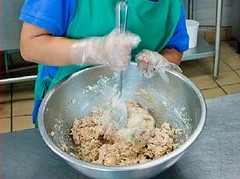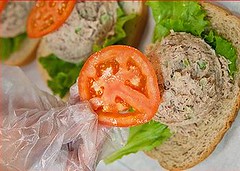獨立研究建議:孩子不該每天吃鮪魚
 美國民間智庫團隊「汞政策計畫」(Mercury Policy Project)19日公布一項首次研究校園營養午餐含汞的研究報告,結果發現,喜歡吃鮪魚的小孩可能面臨汞中毒的極大風險。
美國民間智庫團隊「汞政策計畫」(Mercury Policy Project)19日公布一項首次研究校園營養午餐含汞的研究報告,結果發現,喜歡吃鮪魚的小孩可能面臨汞中毒的極大風險。
研究結果呈現經常食用鮪魚的人汞含量比聯邦法律規範的安全汞含量值超出40倍。這份報告的共同作者Ned Groth博士稱聯邦法律規範的安全汞含量為「過時且無法提供充分的保護」。
根據美國聯邦有毒物質及疾病登記署資料顯示,人類的神經系統對於任何型態的汞都非常敏感,研究顯示汞中毒的孩童可能在神經系統出現學習及認知功能障礙的問題、消化系統失調及腎功能損害。
Groth博士警告汞對孩童的影響個別差異很大,經常食用鮪魚的消費者可能會「接觸到這種有毒元素時,對認知及學習能力產生微妙的影響。」
這份報告名為「鮪魚大驚奇」(Tuna Surprise),內容包括第一份對銷售到學校的鮪魚所做的汞測試結果,及評估孩童從鮪魚罐頭所攝取的汞含量。
由於價格低廉、並是營養豐富的低脂蛋白質來源,鮪魚透過通過聯邦政府資助的學校午餐計劃提供給各學校。在今年秋天新的學校午餐規範實施後,學校或許會調整他們的蛋白質來源。
有別於官方8年前公布的報告,這份獨立報告顯示,甲基汞對人體產生負面影響的最低值,比過去認為來得低的多。
在美國飲食中,鮪魚罐頭是甲基汞最大的來源,美國人體內幾近1/3的汞化合物皆由此而來。
汞政策計畫領導人Michael Bender表示:「就我們所知,過去從未在這個部分進行相關檢驗。」
檢驗販售到學校的鮪魚後發現,鮪魚的汞含量跟其他研究於超市販售的鮪魚罐頭中測得的數據相近。長鰭鮪魚(一般稱為白鮪魚)的汞含量遠高於小黃鰭鮪,兩種鮪魚的汞含量皆有高度變異。
報告中建議校方或家長不要提供任何長鰭鮪魚給孩童食用,並建議小黃鰭鮪提供量限制在一個月兩次、25公斤(55磅)以下的幼童最好一個月食用一次就好。
Bender表示,「多數孩童的鮪魚食用量已經受到控制,並不會有顯著的風險;我們應該關注那些經常食用鮪魚的孩童,藉由提供低汞含量海鮮或其他營養來源以降低他們的體內汞含量。」
由於測試汞含量的結果明顯高於其他地區,報告中特別提及避免食用來自拉丁美洲國家的鮪魚,尤其是厄瓜多。
目前,美國孩童食用鮪魚的比例是其他魚種的兩倍,美國的海鮮餐約有1/6提供鮪魚罐頭。
公益科學中心食品安全計畫的專職律師Sarah Klein表示,「魚類(包含鮪魚)通常是健康飲食習慣的營養來源。但我們必須確保幼小、脆弱的孩童從鮪魚中得到的汞不會超過鮪魚的營養價值。我們呼籲家長和校方限制鮪魚的供給量;若一定要供給鮪魚,則需要挑選含汞量較低的。」
 「安心聯盟」(Coalition for Safe Minds)成員Eric Uram表示,「如同報告呈現,小黃鰭鮪的汞含量僅為長鰭鮪魚的1/3;不過如果參考聯邦魚類消費建議,牠們絕對不是低汞魚類。」
「安心聯盟」(Coalition for Safe Minds)成員Eric Uram表示,「如同報告呈現,小黃鰭鮪的汞含量僅為長鰭鮪魚的1/3;不過如果參考聯邦魚類消費建議,牠們絕對不是低汞魚類。」
紐約Pelham 的環境健康科學家Groth博士分析不同年紀的孩童吃了不同汞含量的鮪魚數據後發現,並探討不同情境下相對的汞含量與風險。發現不同情境下的汞含量從聯邦標準的1/4到40倍。
Groth博士表示:「經常實用鮪魚的孩童很容易有高的汞含量,有些高到遠超過可接受範圍。」
鮪魚體內汞的兩種來源:人類活動及自然過程
Groth博士向ENS的記者表示:「數十億年來汞自土地釋出,可能來自岩石或火山爆發。而自從工業革命以來,人們藉由燃燒煤將汞釋放到大氣中、再由大氣落回海洋、河流及濕地。接著環境中的細菌把汞吃掉轉換成甲基汞,而以這種化合物進入食物鏈中。」
甲基汞被海中的藻類吸收後隨著食物鏈累積越來越濃—小動物吃海藻、小魚吃小動物、中魚吃小魚、食物鏈高層消費者(如鮪魚)吃中魚,因而食物鏈越上層生物體內會累積越多的汞。
「這個自然過程同時反映了自然產生及人為污染製造的汞。如果我們檢視19世紀的鮪魚樣本,我們同樣會發現汞的存在。」
本報告的共同作者Catherine Thomasson博士表示,「非常令人遺憾這樣一個平價的蛋白質來源受到了汞污染;為了降低風險,我們需要降低孩童食用鮪魚及降低主要來自燃燒煤的火力發電產生的汞污染。」Thomasson博士同時也是社會責任醫生組織的執行董事。
由上述內容,這份報告提出以下建議:
- 孩童不該每天攝食鮪魚,且孩童不該攝食長鰭鮪魚。
- 體重高於25公斤的孩童一個月至多吃兩次小黃鰭鮪,6盎司的鮪魚含汞量在可接受的風險範圍內。
- 體重低於25公斤的孩童一個月至多吃一次鮪魚。
- 家長或學校應提供其他的海鮮選項,如蝦或鮭魚,這些海鮮同樣營養且含汞量較低。
- 聯邦政府資助的學校午餐計劃應逐步削減鮪魚罐頭用量,改用其他低汞量海鮮或是其他蛋白質來源替代。
- 家長應監管孩童在學校的鮪魚罐頭攝取量,確保在家裡及學校加起來的總攝取量不超過建議量。
「鮪魚大驚奇」報告由公益科學中心、社會責任醫生組織、安心聯盟、環境健康政策中心、Got Mercury?、Clean Wisconsin、Massachusetts Clean Water Action、Massachusetts Clean Water Action、Vermont Public Interest Research Group及歐洲環境聯合會等團體共同發表。
Children who love to eat tuna fish may be at greater risk of mercury poisoning than anyone has realized, finds the first study on mercury in school lunches published Wednesday by the Mercury Policy Project.
Analysis of the research results shows that frequent tuna eaters can be exposed to more than 40 times the current federal definition of safe mercury exposure, which report co-author Dr. Ned Groth calls “way out of date and not protective enough.”
The human nervous system is very sensitive to all forms of mercury. Research has shown that children poisoned by mercury may develop problems of the nervous system with learning and cognitive impairment, and suffer disorders of the digestive system and kidney damage, according to the federal Agency for Toxic Substances.
Dr. Groth warns that while individual children vary widely in how mercury affects them, frequent tuna consumers can experience “subtle effects on cognitive ability and learning when exposed to this poisonous element.”
The report, “Tuna Surprise,” contains the first test results for mercury in tuna sold to schools and assesses children’s mercury exposure from canned tuna.
Mercury Policy Project researchers tested the mercury content of 59 samples, representing eight brands of tuna, sold to schools in 11 states.
An inexpensive and nutritious low-fat protein source, canned tuna is served through the federally subsidized school lunch program. And schools may be switching to leaner protein sources this fall as they implement the new school lunch standards.
Independent studies, not available when government advisories were issued eight years ago, indicate that adverse effects of methylmercury occur at much lower levels of exposure than previously thought.
Canned tuna is by far the largest source of methylmercury in the U.S. diet and accounts for nearly one-third of Americans’ total exposure to this toxic mercury compound.
“As far as we know, no one has previously tested this market sector,” said Michael Bender, MPP’s director.
Testing of tuna sold to schools showed that the tuna contains mercury levels similar to what other investigations have found in canned tuna sold in supermarkets. Albacore or “white” tuna had much higher mercury levels than did “light” tuna, and mercury levels in both types were highly variable.
The report advises schools and parents not to serve any albacore tuna to kids and to limit consumption of light tuna to twice a month for most kids and only once a month for smaller children, under 55 pounds.
“Most children are already consuming only modest amounts of tuna and are not at significant risk,” said Bender. “So the focus really needs to be on kids who eat tuna often, to limit their mercury exposure by offering them lower-mercury seafood or other nutritious alternatives.”
One specific warning in the report is to avoid tuna from Latin American countries, particularly Ecuador, as it tested higher for mercury content than tuna produced in other countries.
Currently, American kids eat twice as much tuna as they do any other kind of fish, and one out of every six U.S. seafood meals is canned tuna.
“Fish, including tuna, is generally a nutritious part of a healthy diet,” said Sarah Klein, staff attorney in the Food Safety program at the Center for Science in the Public Interest. “But especially for our littlest, most vulnerable children, we have to make sure the risks from mercury in tuna don’t outweigh tuna’s benefits. We’re urging parents and schools to limit children’s tuna consumption and, when they do serve it, to choose lower-mercury options.”
“As the report states, light tuna has one-third as much mercury as albacore does,” said Eric Uram of Coalition for Safe Minds. “But contrary to the current federal fish consumption advisory, it is definitely not a low-mercury fish.”
Dr. Groth, an environmental health scientist based in Pelham, New York, analyzed a variety of scenarios in which children of different ages ate different amounts of tuna with different mercury levels, and examined the relative exposure and risk from each scenario. Exposures in those scenarios ranged from less than one-quarter of to more than 40 times the current federal definition of safe exposure.
“Kids who eat tuna frequently can easily get very high mercury doses,” says Dr. Groth. “Some of the larger doses are clearly far too high to be acceptable.”
The mercury in tuna comes from two sources – human activities and natural processes.
Dr. Groth told ENS, “For billions of years mercury has been leaching out of the land. It occurs in rocks and in volcanic emissions. Since the Industrial Revolution, he explained, “humans have been putting mercury into air from coal burning. It falls into oceans and on rivers and wetlands. Once there, bacteria in those environments eat mercury and convert it to methylmercury – this compound gets into the food chain.”
Methylmercury is absorbed by algae in ocean water and becomes more and more concentrated as it moves up the food chain – small animals eat the algae, small fish eat the small animals, medium fish eat the smaller fish and top predators such as tuna that eat the medium-sized fish have the highest concentrations of mercury in their bodies.
“This is largely a natural process responding to both natural and pollution inputs of mercury,” said Groth. “If you look at mercury samples from the 19th century, they had mercury in their tuna too – it’s a fact of life.”
“It’s a shame that such a great source of inexpensive protein is contaminated with mercury,” says Dr. Catherine Thomasson, executive director of Physicians for Social Responsibility, which co-released the report. “To reduce risk, we need to both reduce children’s exposure to tuna and reduce mercury pollution the majority of which is from coal-burning power plants.”
With this in mind, the report recommends:
No child should eat tuna every day and children should not eat albacore tuna. Albacore or “white” tuna contains triple the mercury level of light tuna; nothing justifies tripling a child’s mercury dose.
Children weighing more than 55 pounds should not eat more than two servings of light tuna per month. This amount of tuna (six ounces) is more than the average child currently consumes; the mercury dose it contains is acceptably low in risk.
Children up to 55 pounds should consume no more than one tuna meal per month. Because of their smaller body size, an added margin of caution is appropriate for younger children.
Parents and schools should offer children other seafood choices, such as shrimp and salmon, which are just as nutritious but contain far less mercury.
The U.S. Department of Agriculture’s School Lunch Program should phase out commodity purchases of canned tuna, and replace it with lower-mercury alternative seafood items and other extra-lean protein sources.
Parents should monitor their children’s canned tuna consumption at school and ensure that the total consumed at home and at school does not exceed the recommendations for exposure.
“Tuna Surprise” was co-released Wednesday by the Center for Science in the Public Interest, Physicians for Social Responsibility, Coalition for Safe Minds, Environmental Health Strategy Centers, Got Mercury?, Clean Wisconsin, Massachusetts Clean Water Action, Vermont Public Interest Research Group and the European Environmental Bureau.
※ 全文及圖片詳見:ENS


